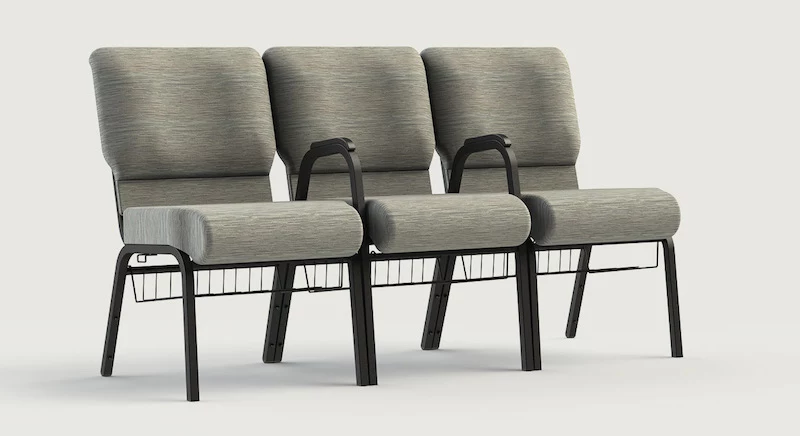Pews vs. Chairs: The Unspoken Truths of Upgrading Your Sanctuary Seating
I’ve spent a lot of my career in the middle of a really tough conversation that happens in churches. It’s a decision that hits right at the heart of tradition, comfort, and what the future of a community looks like. I’m talking about the big switch from classic wooden pews to modern, flexible church chairs.
In this article
Let’s be honest, this is way more than a furniture upgrade. For a lot of people, those pews are part of the family. They know the exact spot their grandparents sat. The wood itself feels like it holds the memories of baptisms, weddings, and emotional goodbyes. So, the very first mistake any leadership team can make is to blow past those feelings. You have to start by acknowledging the history wrapped up in that wood.
My job isn’t to sell you on chairs. It’s to give you a real, no-nonsense game plan for making the best choice for your community. I’ve seen this process unite people, and I’ve seen it cause deep rifts. The difference almost always comes down to good communication and really understanding what you’re getting into. So, let’s walk through it all, from the nitty-gritty of chair construction to the fine print on fire codes.

What Are We Actually Talking About? Pew vs. Chair Guts
Before you can compare, you need to know what you’re looking at. A traditional pew isn’t just a long bench, and a good church chair is a seriously engineered piece of gear. Their construction is everything when it comes to comfort and lifespan.
The Soul of a Pew
Most of the classic pews out there are made from solid wood, usually red oak because it’s tough and has a beautiful grain. The way they’re put together is a masterclass in old-school woodworking. The end pieces are thick and solid, connected to the seat and back with strong joints that lock them together. This is why a well-made pew can easily last a century or more. Its weakness, though, is its strength: that solid, unmoving wood offers absolutely zero forgiveness for the human body.
Breaking Down a Modern Church Chair
A quality church chair is commercial-grade furniture built to take a beating. Here’s what you need to look at:

- The Frame: This is almost always steel. And here’s a pro tip: pay attention to the gauge. A 16-gauge steel frame is thicker and way more durable than an 18-gauge frame (lower number = thicker steel). Also, check the finish. A powder-coated finish is baked on and resists chipping and scratches far better than simple paint.
- The Foam: This is where people get it wrong. They go for what feels softest in the showroom, not what will last. The key is density, measured in pounds per cubic foot. A cheap chair might use 1.2-pound foam that feels great at first but will be a flat, uncomfortable pancake within a year. You should be looking for virgin commercial-grade foam that’s at least 1.8 pounds, and honestly, 2.0 pounds or higher is even better. It feels a bit firmer initially, but it provides support that actually lasts.
- The Seat Base: Underneath that foam, you need a solid platform. A quality plywood base is good. Some chairs use a metal seat pan, which can also offer fantastic long-term support. Don’t be afraid to ask the supplier, “What’s under the cushion?”
- The Fabric: You absolutely need commercial-grade fabric. The durability is often measured in “double rubs.” For a high-use sanctuary, look for a rating of at least 100,000 double rubs, but I’d strongly recommend aiming for 200,000 or more. These fabrics are also designed to be stain-resistant and easy to clean. Darker colors and patterns are also way better at hiding small stains than solid light colors—just a little practical tip!
By the way, let’s talk about the elephant in the room: cost. The price tag on these chairs can vary wildly. A basic, entry-level chair that will get the job done might start around $75. On the high end, a premium chair with all the best features could be $150 to $250. From my experience, the sweet spot for long-term value—getting that durable frame and high-density foam without breaking the bank—is often in the $120 to $160 range per chair.

The Hidden Factors: How Seating Changes Your Room
Swapping pews for chairs does more than just change the look; it changes the physics of the room and how it feels to be in it. This isn’t just a matter of opinion—it’s science.
The Ergonomics of an Hour-Long Service
Think about it: a typical pew is a flat board with a straight back. It offers zero support for the natural curve of your lower back (the lumbar region). When you sit on a hard surface for a while, all your weight presses down on your sit bones. This can lead to numbness, tingling, and back pain. It’s why you see people constantly shifting and fidgeting on pews.
A well-designed chair fixes this. The cushion distributes your weight, but more importantly, the backrest has built-in lumbar support that fills that gap in your lower back. Another key feature is a “waterfall” front edge on the seat, which curves down to relieve pressure behind your knees and helps circulation. For older members, armrests are non-negotiable. I’ve seen it myself—those arms are what allow someone to lower themselves down and push themselves back up safely. It can literally be the difference between a longtime member attending independently or not at all.

The Overlooked Issue: Acoustics
Heads up! This is one of the most forgotten parts of the process. Wood is a hard, reflective surface. Sound waves from a speaker, the choir, or an organ bounce off pews, creating a live, vibrant sound. It’s a huge part of the acoustic signature in a traditional sanctuary.
Upholstered chairs are the exact opposite. They are soft and absorbent. They soak up sound, especially higher frequencies. When you replace all that reflective wood with fabric and foam, you will fundamentally change how your room sounds. The room will become acoustically “drier” or more “dead.” Speech might sound clearer with less echo, but music and congregational singing can feel weaker and less powerful.
I learned this one the hard way. A church installed beautiful chairs, and everyone loved the comfort. But the music director was heartbroken because the choir suddenly sounded thin and the room’s energy was gone. Now, I always recommend a consultation with an acoustics professional. You can find one by searching online for members of the National Council of Acoustical Consultants (NCAC) or by asking a local high-end AV installation company for a recommendation. A basic consultation might run you $1,000 to $2,500, but it can save you from an acoustic disaster.
Getting it Right: Layout, Planning, and Avoiding Common Disasters
Flexibility is great, but it only works if you plan your layout with care. You can’t just start dropping chairs wherever you feel like it.
The 5 Pitfalls That Can Wreck Your Seating Project
Over the years, I’ve seen the same mistakes pop up again and again. Here are the big ones to watch out for:
- Ignoring the Emotions: Rushing past the history and emotional attachment to the pews. This is a guaranteed way to create division before you even start.
- Forgetting the “All-In” Cost: Only budgeting for the per-chair price and forgetting about shipping, assembly, accessory, and pew disposal costs.
- Guessing on Fire Codes: Not getting official guidance on aisle widths and row spacing from your local fire marshal. This can lead to a failed inspection and a huge, expensive mess.
- Buying Sight Unseen: Ordering hundreds of chairs without getting a physical sample first to test for comfort and build quality.
- Ignoring Acoustics: Swapping reflective wood for absorptive fabric without considering how it will deaden the sound of music and singing in your sanctuary.
Layouts That Actually Work
Once your code requirements are met, you can think about design. Straight rows are fine, but curved (or radius) rows can create a much more intimate atmosphere. You don’t need a laser transit to do this! Here’s a quick-and-dirty method for volunteers:
Quick tip for radius rows: You can create a perfect arc with just a string, two people, and some painter’s tape. First, find the center point of your arc. Have one person hold the end of the string at that center point. Have the second person walk the arc with the other end of the string pulled taut, placing small pieces of tape on the floor every few feet. Voila! You have a perfect curve to line up the front legs of the first row of chairs.
Oh yeah, and make sure your chairs have good ganging clips. These are connectors that lock the chairs together into solid rows. This is often a fire code requirement to prevent chairs from scattering and blocking aisles in an emergency. Make sure the clips are easy for your volunteers to use but strong enough to hold.
The Nitty-Gritty: Money, Maintenance, and Making it Happen
A successful transition comes down to being realistic about the money and the labor involved. It’s time for some frank talk.
The Full Budget Breakdown
Remember, the price on the chair is just the beginning. Your real budget needs to include:
- Freight Shipping: Chairs are heavy. Shipping 300 of them is a major expense. Get a firm quote.
- Assembly: Will they arrive assembled? If not, plan for either a massive volunteer effort or the cost to have them assembled professionally.
- Pew Removal: What are you doing with the old pews? Offering them to the congregation for a donation can work well. I once saw a church partner with a local woodworker who turned the old oak into beautiful new furniture, giving a cut back to the church. Have a plan before they’re uninstalled.
- Accessories: Need book racks? Communion cup holders? Storage dollies? Add them to the per-chair cost.
Chair Care vs. Pew Care
Pew maintenance is infrequent but complex. Chair maintenance is simpler but more routine. I suggest creating a small team to do an annual check-up. They should go through with a wrench and tighten every bolt on every chair. A loose bolt is the #1 cause of a wobbly, failing chair. You’ll also want to order about 2-3% more chairs than you need. That way, when one gets damaged, you can easily swap in a spare while the other is repaired.
And if you’re planning for a multi-use space, you have to think about logistics. The average church chair weighs around 20 pounds. Moving 200 of them means your volunteer team is lifting 4,000 pounds (or 2 tons!) every single time you reconfigure the room. Good, sturdy dollies made for your specific chairs aren’t a luxury—they’re an absolute necessity for safety and efficiency.
Making the Final Call: Your Step-by-Step Checklist
Alright, after all the research and discussion, it’s go-time. This whole process, from forming a committee to installation day, can easily take 6 to 12 months, so it pays to be organized. Here’s my final checklist for a successful outcome.
- Get Samples. Period. Never, ever buy chairs without seeing them first. A good supplier will send you a sample. Get one from your top 2 or 3 choices and compare them side-by-side.
- Run a “Sit Test.” Put the samples in a high-traffic area and let a diverse group of people—young, old, tall, short—sit in them for an extended period. Not just five minutes. Get their real-world feedback.
- Read the Warranty. A “lifetime frame warranty” sounds amazing, but it usually only covers a catastrophic weld failure. It almost never covers the foam or fabric. Look for a strong, separate warranty on the components that actually wear out, like 10-15 years for foam and 5-10 years for fabric.
- Check References (The Right Way). Don’t just ask, “Do you like the chairs?” Ask specific, probing questions. A good script is:
- “After a few years, how has the foam held up? Is it still comfortable or has it gone flat?”
- “Have you had any issues with the ganging clips breaking or being difficult for volunteers to use?”
- “When you had a problem, how was their customer service? Did they solve it quickly?”
- Get Official Code Approval. I can’t say this enough. This guide is a framework, not a legal document. You must consult your local fire marshal and building inspector to get your final layout plan approved before you place your order.
Choosing to replace your pews is a massive decision, I get it. But by blending respect for tradition with careful planning and a deep dive into the technical details, you can absolutely make a choice that will serve your congregation comfortably and safely for years to come.
Inspirational Gallery
What about the acoustics? It’s a question that often gets missed.
Sanctuary sound is a delicate balance. Hard, reflective surfaces like wooden pews and stone floors create the reverberation that makes organs and choirs soar. When you replace pews with upholstered chairs, you’re introducing hundreds of soft, sound-absorbing surfaces. This can be a huge benefit for spoken-word clarity, reducing echo and making sermons easier to understand. However, it might slightly dampen the musical ‘live-ness’. The solution is often a compromise: choose chairs with fabric on the seat and inner back, but with an outer back made of polymer or wood to retain some reflective quality.
More than 70% of churches now use their main sanctuary for non-worship events during the week, from community meetings to daycare services.
This dramatic shift is a key driver behind the move to flexible seating. Pews lock a room into a single purpose, but chairs unlock its potential. A space can host a Sunday service in the morning, be cleared for a children’s playgroup by noon, and be set up with round tables for a community dinner in the evening. This versatility not only serves the congregation but also transforms the church into a true seven-day-a-week community hub.
The fabric choice is about more than just color. It’s a 10-year decision.
Woven Fabrics: Offered by mills like Absecon, these have a comfortable, residential feel. They breathe well and offer immense variety in texture and pattern. Their downside? They are more susceptible to staining and harder to deep clean.
Coated Fabrics (Vinyl): These are the workhorses. Modern versions are surprisingly soft, but their superpower is cleanability. Spills wipe right off, making them ideal for churches with young families or frequent fellowship meals. They are the top choice for durability.
Don’t forget the ganging clips! This tiny piece of metal is the secret to transforming hundreds of individual chairs into neat, stable rows that feel like a unified bench. Most quality church chairs, like those from Sauder Worship Seating or ComforTek, have built-in ganging devices that interlock seamlessly. When evaluating chairs, ask to test this feature. A good system is strong, easy to engage, and doesn’t rattle. It’s the detail that makes flexible seating feel permanent and orderly.
- Keep the sanctuary clear of tripping hazards.
- Ensure fast and orderly exits in an emergency.
- Maintain a sense of reverence and order.
The secret? Your local fire code. Before you even think about chair models, consult your local fire marshal. They will dictate the mandatory aisle widths (often 36 to 44 inches) and the maximum number of chairs allowed in a continuous row, which directly impacts your total seating capacity.
What happens to the old pews?
This is often the most emotional part of the transition. Throwing them away feels sacrilegious. Consider a ‘Pew Legacy Project’: offer to cut the pews into smaller, 2-foot keepsake sections for congregants in exchange for a donation towards the new chairs. The remaining wood can be beautifully repurposed by local woodworkers into welcome desks, altar tables, or smaller benches for the church foyer, preserving a piece of history within the renewed space.
A key quality indicator is the use of ‘T-Nuts’ instead of wood screws for assembly.
It sounds technical, but it’s crucial for longevity. Wood screws bite directly into the plywood seat base, and over time, with constant use, they can loosen and strip the wood, leading to the dreaded wobbly chair. T-Nuts, a feature championed by brands like Bertolini, use a metal-on-metal connection (a bolt going into a metal T-Nut). This creates a vastly stronger and more durable joint that can be re-tightened if ever needed, ensuring the chair remains stable for its entire lifespan.
Important point: Check the foam density. Low-quality chairs use cheap, low-density foam that feels plush in the showroom but will compress and ‘bottom out’ within a year. For a chair that will be used for hours every week, look for high-density virgin foam, often specified as 1.8 lbs per cubic foot or higher. Some premium options even incorporate a layer of memory foam for added comfort. It’s what’s inside that counts for long-term comfort.
When integrating modern chairs into a traditional sanctuary, look for subtle ways to create harmony.
- Match the chair’s metal frame finish (e.g., a textured silver or bronze) to existing light fixtures or metalwork.
- Choose a fabric color that picks up on a secondary color in the stained-glass windows.
- Opt for a chair model with a slightly arched back that echoes the shape of the building’s windows or vaulted ceilings.
- How will we store them?
- Are our doorways wide enough for the dollies?
- Will the chair feet damage our flooring?
These are the logistical questions to answer before you place an order. Calculate the square footage needed for chair dolly storage. Measure your narrowest doorway. And always opt for chairs with gentle nylon glides on their feet to protect wood or tile floors from scratches during rearrangement.










